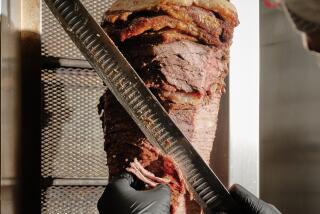Cheese of the Pharaohs
- Share via
The cheeses of Egypt are distinctive but little known in this country. And some of them are going to stay little known, because they’re traditionally cured by being buried in the salty soil of the Nile Delta. That’s practically calculated to make the FDA’s hair stand on end.
And then there’s mish, a nutritious product made by fermenting cheese in salted whey for months or even years. It’s a mainstay of the Egyptian peasant and an appetizer for everybody else in the country. If you want to say something is commonplace, you say, “It’s everywhere, like mish.”
But mish is not for Cheddar-lovers. It’s extremely salty and sharp, with a distinct ammonia smell like some blue cheeses. And then there’s the worm thing.
It so happens that mish often breeds tiny worms, which are annoying, though not dangerous. There’s another proverb just about them--du^d el-mish minno fi^h, “the worms of the mish arise from it”--which refers to a problem inherent in a situation. It’s sort of the Egyptian way of throwing up your hands and saying, “Hey, whattaya gonna do?”
One Egyptian cheese, however, has made its way in the world, via Cyprus. You can often find haloumi cheese in cheese stores or Greek restaurants. It’s a mild, chewy sheep’s or goat’s milk cheese, usually with a hint of mint (because the process involves layering cheese with mint leaves), which is stored in brine like feta.
It originated in Egypt, where “halo^m” was the word for fresh cheese in the ancient Coptic language. By the Middle Ages, the Arabs were making halu^m by the layering process, but the surviving medieval recipe happens to mention thyme, rather than mint. It could be eaten fresh or aged, but the same recipe insists that it be covered with olive oil, which would hermetically seal it. Tough luck for worms.


